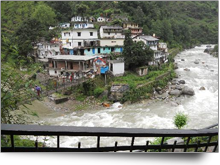
Guptakashi, Gupta Kashi or Guptkashi is a fairly large village located at an elevation of 1,319 metres (4,327 ft) in the Kedar-khanda ('khanda' means "sector"), in Garhwal Himalayas ofRudraprayag district in Uttrakhand, India. It is famous for the ancient Vishwanath Temple - dedicated to god Shiva - similar to the one in Varanasi (Kashi). The other famous temple here is dedicated to Ardhanareshvara (a half man half woman form of Shiva and Parvati). The name Guptakashi has legendary significance linked to the Pandavas, the heroes of the Hindu epicMahabharata.[1][2][3] Its religious importance is considered next to that of Varanasi, believed to be the most pious of all Hindu pilgrimage places.
The temple town is located on the way to the Kedarnath, one of the Chota Char Dhams and Panch Kedars. It has the scenic backdrop of the snow covered peaks of Chaukhamba and enjoys a salubrious weather throughout the year.
Structures
The main temple is dedicated to Shiva as Vishwanath (ruler of the world). The architectural style of this temple is akin to other temples in Uttrakhand, such as Kedarnath, built in stone with a high tower over the sanctum and a wooden frame and sloping roof in typical architectural style of the region, at the top of the tower. At the entrance to the temple, there are two dwarpalakas (entrance guards) on both sides. The exterior façade is painted with lotuses. At the top of the entrance door, there is an image of Bhairava, a terrible form of Shiva. To the left of the main shrine, there is a smaller shrine dedicated to Ardhanareeshvara and at the entrance to this temple there is metallic statue of Nandi facing Shiva’s image in the temple and offering reverential worship. This statue has a Swastika, a typical Hindu symbol, painted on its side, with its arms aligned in a clockwise direction, considered as an auspicious direction.
Apart from the main Vishwanath temple, a large number of Lingas, symbols of Shiva, are seen in and around Guptakashi, which has resulted in the popular terminology ‘jitne pathar utne shankar’ meaning “as many stones, those many 'Shiva's”. Another temple town called the Ukhimath is located on the opposite bank of the Mandakini river where, during the winter months when Kedarnath temple is inaccessible due to snow conditions, the symbolic deity of Kedarnath is shifted via Guptakashi to Ukhimath to continue worship uninterrupted. The temple priests of Kedarnath stay at Guptakashi during the winter period.
In a small pond (kund) called the Manikarnika Kund here, in front of the temple, a Shiva-linga is bathed by two springs, representing the rivers Ganges (Bhagirathi) and Yamuna. The Yamuna spring water emanates from a goumukh(spout in the shape of a cow’s mouth) and the Bhagirathi spring flows through trunks of two elephants strategically placed above the linga.
In addition, there are few other important sites to visit in the vicinity of the temple town. These are the Gandhi Sarovar (lake) 2 kilometres (1.2 mi) from the town where the ashes of Mahatma Gandhi were immersed. Vasukital, 8 kilometres (5.0 mi) from Kedarnath, is yet another enchanting lake that beholds the visitor with floating ice and sparkling water.
At Ukhimath, on the opposite bank of the river, there is a stupa, which according to the local version represents the grave of Nala. There are also evidences of a love legend narrated, locally only, of Krishna’s grand son Aniruddha and demon king Banasura’s daughter Usha at Ramgarh (in Ronitpur), near Ukhimath, about3 kilometres (1.9 mi) away from Guptakashi. This love affair led to a war between Krishna and Banasura in which the latter was killed, resulting in the end of Banasura's dynasty.
Guptakashi is located in the Northern Himalayan belt within the Mandakini river valley, which has lush green forests. A number of streams and rivulets drain into the main Mandakini River. It has salubrious climate with its elevation being around 1,319 metres (4,327 ft). The snow sparkling view of the Chaukhamba peak is a lovely sight to behold in the morning hours from here. The valley has large magnolia trees (locally called Champa) that provide a sweet scented atmosphere to the place. The temple of Madhyamaheshwar is 25 kilometres (16 mi) northeast of Guptkashi. The road from Guptkashi to Kalimath and the trek from Kalimath to Madhmaheshwar provide the scenic beauty of Chaukhamba, Kedarnath and Neelkanth peaks.
